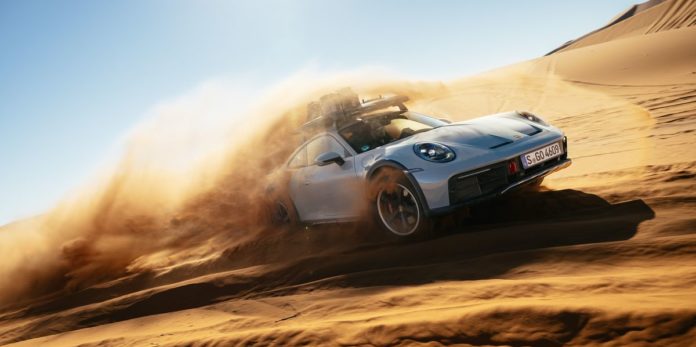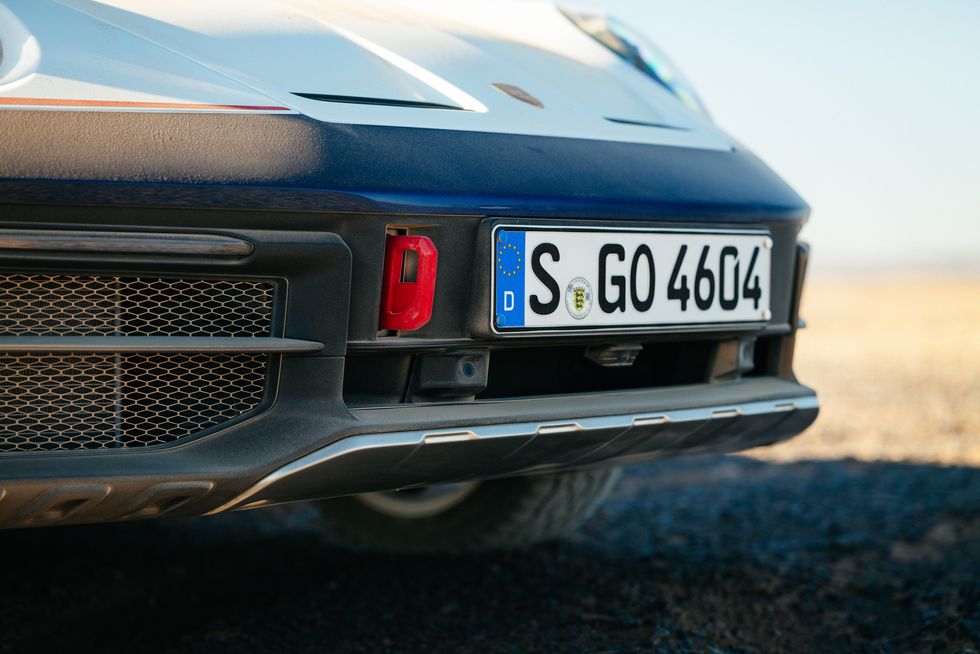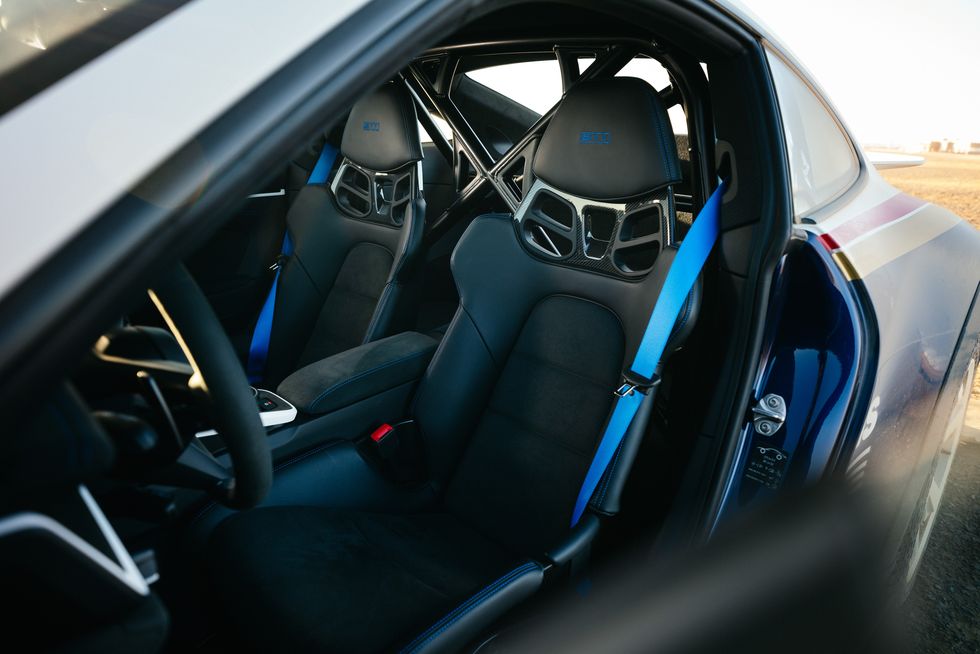“Aired Down a Porsche 911” has never appeared on any bingo card we’ve ever held, and yet here we are, deflating our 911 Dakar’s tires before play commences on a massive Moroccan sand dune formation called Erg Chebbi. It’s not immediately clear how well we’ll fare in the big dunes, a visit to which normally requires a rented Toyota Land Cruiser Prado or a local camel-caravan outfitter. Thus far, we’ve been traversing desert hardpan and gaping like tourists at the odd meandering single-hump dromedary while attempting to avoid rocks and well-intended cairns hidden behind persistent hanging curtains of choking dust.
Earlier, while we cruised through dusty towns that seemed to be the inspiration for Star Wars‘s Tatooine, kids sometimes waved (that was a wave, wasn’t it?) as we passed by in our shiny Land Speeders. Then, at the last checkpoint before the open desert, the local constabulary stopped our three-car convoy, whereupon the lead driver was obligated to hand over . . . his Instagram handle. (The next day, on the way back, he would be required to perform . . . a launch control start.)
It turns out that the Erg—a dead ringer for Southern California’s Glamis sand dunes (which played the part of Tatooine, come to think of it)—is literally the 911 Dakar’s sandbox. It makes sense, because the 911 Dakar is essentially a quarter-million-dollar dune buggy that’s based on the mighty Carrera 4 GTS instead of a Volkswagen Beetle.
Like an OG dune buggy, the Dakar has a rear-mounted engine, a pan-flat floor, and broad rear tires that are proportional to the 911’s inherent rear-biased weight distribution and provide handy flotation in sand. Lightweighting measures mean that its curb weight is only some 20 pounds heavier than a Carrera 4 GTS, so even though it does weigh around 3550 pounds, it makes much less of an impression in the sand than your average SUV and undercuts a base Porsche Macan by some 600 pounds.
From there this Porsche takes the dune-buggy format several giant steps forward on account of its wailing 473-hp twin-turbo 3.0-liter flat-six engine from the GTS. This engine’s broad torque peak of 420 pound-feet from 2300 to 5000 rpm is even more critical. In the thick of it, whenever we glanced at the tach, usually while yelling, “I can’t believe I’m doing this in a 911!” the engine was invariably grinding it out between 3000 and 4000 revs, happy as we were in mountains of dry sand.
Another incongruous element in all of this is the interior, which, despite tasteful Dakar touches and trim choices, never misses a chance to remind that you’re still in a 911. The microsuede-wrapped steering wheel is one example: The wheel is in so much constant motion as you saw through the sand that the top-center hash mark seems laughably pointless. Ditto the one-piece carbon race buckets, which beat you up like a boxing opponent when you’re bouncing around out there. Pro tip: Opt instead for the (no-cost) heated leather GT Sport steering wheel and ditch the hard-shell buckets for 18-way power-adjustable heated sport seats (another no-cost option).
If you hadn’t already guessed, the Carrera 4 GTS also donates its all-wheel-drive system with Porsche Traction Management and Porsche Torque Vectoring Plus. To these, the Dakar adds GTS options such as rear-wheel steering and the Porsche Dynamic Chassis Control system of active anti-roll bars, and the combination of all of that, plus a caravan load of software optimization, gives the added Rallye and Offroad driving modes some real teeth.
As the name implies, Rallye shifts the torque bias rearward and sets up the active anti-roll bars and rear-steer systems to promote controllable rally-style oversteer on loose, gravelly surfaces. But these are adaptive systems, so they can reel things in if the pendulum swings too far. Offroad mode delivers a more even front/rear torque split, and it can relax the anti-roll bars and lock the rear differential to maintain forward progress on uneven terrain. Both modes’ baseline torque splits are more like guidelines than actual rules, as the system has the bandwidth to shunt torque anywhere from 88 percent front to 100 percent rear, depending on where the traction is.
To this, the Dakar has one final ace up its sleeve: increased static ride height, plus a farther 1.2-inch suspension lift. Automatically deployed in Offroad mode and manually selectable in other modes, the system raises the Dakar’s belly from a healthy 6.3 inches of standard clearance (1.8 inches more than in the GTS) to 7.5 inches of maximum clearance. The 911’s short 96.5-inch wheelbase translates that into a respectable 19.0-degree breakover angle, which is firmly in crossover SUV territory. This proved handy in the dunes, where high-centering was never a concern.
But let’s not kid ourselves. Even with reprofiled front and rear overhangs, the Dakar’s 16.1-degree approach and 18.2-degree departure angles are too shallow for truly rocky trails. If there’s any doubt, enlist your passenger as a spotter. The standard surround-view camera can only reveal so much, and there are low-hanging turbos in the rear corners. L.A. driveways, however, should be a cinch. You won’t even need to engage the lift to clear them.
The lift system employs coil springs resting atop an upgraded version of the hydraulic front-end lift that’s optional on other 911s. A similar lift mechanism is fitted at the rear, and the engineers added an accumulator and a more robust pump so the system can maintain the raised posture indefinitely so long as speed doesn’t exceed 105 mph. To further optimize the suspension for work on rough terrain, the PASM front strut and rear damper bodies are longer and rigged for more travel, and the correspondingly longer springs are softer than their roadgoing counterparts’ by some 50 percent.
None of this would matter without appropriate tires, and the Dakar’s bespoke Pirelli Scorpion All Terrain Plus knobbies do the work. With 19-inch wheels up front and 20-inchers in back, the Dakar’s wheels are each an inch smaller than the GTS’s. And the 245/45ZR-19 front and 295/40ZR-20 back tires are also about an inch taller from top to bottom, and that combo gives the rims an extra inch of protective sidewall. The enlarged air volume within allows for a lower standard pressure, and that helps the Dakar better cope with rough-textured surfaces. Air them down to 17 psi on sand, as we did, and they provide flotation and traction without digging in.
On pavement, the Scorpion A/T tires are not overly noisy, and they also offer good directional stability and secure steering response. In fact, Porsche engineers were so pleased with their performance that they backed away from their original plan to offer them as an option and made them standard instead. The summer tires are the optional ones here, and rightly so. Buyers who are going to spend nearly $225K—for a car within $1800 of a GT3 RS—probably are doing so for the Dakar’s unique capabilities, and this footwear gives them the best chance to use Porsche’s ultimate dune buggy as intended.
Specifications
Specifications
2023 Porsche 911 Dakar
Vehicle Type: rear-engine, all-wheel-drive, 2-passenger, 2-door coupe
PRICE
Base: $223,450
ENGINE
twin-turbocharged and intercooled DOHC 24-valve flat-6, aluminum block and heads, direct fuel injection
Displacement: 182 in3, 2981 cm3
Power: 473 hp @ 6500 rpm
Torque: 420 lb-ft @ 2300 rpm
TRANSMISSION
8-speed dual-clutch automatic
DIMENSIONS
Wheelbase: 96.5 in
Length: 178.6 in
Width: 73.4 in
Height: 52.7 in
Passenger Volume: 49 ft3
Cargo Volume, Front: 5 ft3
Curb Weight (C/D est): 3550 lb
PERFORMANCE (C/D EST)
60 mph: 3.0 sec
100 mph: 7.6 sec
1/4-Mile: 11.4 sec
Top Speed: 149 mph
EPA FUEL ECONOMY (C/D EST)
Combined/City/Highway: 18/16/20 mpg



